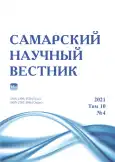Методика изучения изоляции как фактора эволюционного процесса в вузовской дисциплине «Теория эволюции»
- Авторы: Ламехова Е.А.1
-
Учреждения:
- Южно-Уральский государственный гуманитарно-педагогический университет
- Выпуск: Том 10, № 4 (2021)
- Страницы: 273-279
- Раздел: Педагогические науки
- URL: https://journals.rcsi.science/2309-4370/article/view/104931
- DOI: https://doi.org/10.17816/snv2021104306
- ID: 104931
Цитировать
Полный текст
Аннотация
Развитие синтетической теории эволюции, возникшей на основе синтеза дарвинизма, генетики и экологии, сопровождалось открытием факторов эволюции, которые были неизвестны в XIX веке. Открытие изоляции позволило описать механизм сохранения популяций, видов, а также процесс видообразования. В учебной литературе по теории эволюции приводятся определения изоляции, классификация форм изоляции, а также роль изоляции в эволюционном процессе. Изучение изоляции как фактора эволюции нуждается в разработке методики изучения изолирующих механизмов. Реализация этой цели сопряжена с выбором варианта определения изоляции как фактора эволюции. Методически удачным является определение изоляции, описывающее роль этого фактора на начальных этапах микроэволюции и приводящего к появлению новых видов и сохранении их изолированности. При формулировке определения изоляции желательно использование таких терминов, как популяция, вид, поток генов и дивергенция. Изолирующие механизмы проявляются в нескольких формах, что обусловливает необходимость их классификации. Классификация Э. Майра (1974) позволяет при проведении занятий описывать последовательность, взаимосвязь и роль в эволюции основных форм изоляции. С точки зрения методики обучения рекомендуется проведение лабораторных работ при рассмотрении таких форм изоляции, как сезонная, биотопическая и этологическая формы. Реализация предложенной методики изучения изоляции как фактора эволюционного процесса в вузовской дисциплине «Теория эволюции» позволяет повысить эффективность усвоения учебного материала студентами.
Полный текст
Открыть статью на сайте журналаОб авторах
Елена Анатольевна Ламехова
Южно-Уральский государственный гуманитарно-педагогический университет
Автор, ответственный за переписку.
Email: lamehovaea@cspu.ru
кандидат педагогических наук, доцент кафедры общей биологии и физиологии
Россия, ЧелябинскСписок литературы
- История биологии с древнейших времен до начала ХХ века / под ред. С.Р. Микулинского. М.: Наука, 1972. 536 с.
- Воронцов Н.Н. Развитие эволюционных идей в биологии. М.: Прогресс-Традиция, 1999. 640 с.
- История биологии с начала XX века до наших дней / под ред. Л.Я. Бляхера. М.: Наука, 1975. 660 с.
- Ламехова Е.А., Ламехов Ю.Г. Методика изучения закономерностей эволюционного процесса в средней общеобразовательной школе. Челябинск: Изд-во Южно-Урал. гос. гум.-пед. ун-та, 2020. 196 с.
- Георгиевский А.Б. Дарвинизм. М.: Просвещение, 1985. 271 с.
- Dobzhansky Th. Genetics of the evolutionary process. New York, Columbia University Press, 1971. 505 p.
- Майр Э. Популяции, виды и эволюция. М.: Мир, 1974. 465 с.
- Симпсон Дж. Великолепная изоляция. М.: Мир, 1983. 256 с.
- Солбриг О., Солбриг Д. Популяционная биология и эволюция. М.: Мир, 1982. 488 с.
- Северцов А.С. Основы теории эволюции. М.: МГУ, 1987. 320 с.
- Яблоков А.В., Юсуфов А.Г. Эволюционное учение. М.: Высш. шк., 1998. 336 с.
- Северцов А.С. Теория эволюции. М.: ВЛАДОС, 2005. 380 с.
- Ламехов Ю.Г., Ламехова Е.А. Методика изучения популяции в школьном курсе биологии // Самарский научный вестник. 2019. Т. 8, № 1 (26). С. 265–271. doi: 10.17816/snv201981309.
- Большой энциклопедический словарь / гл. ред. А.М. Прохоров. М.: Большая Российская энциклопедия. СПб., 2000. 1456 с.
- Mecham J.S. Isolating mechanisms in anuran amphibians // Vertebrate Speciation / W.F. Blair (ed.). Austin: University of Texas Press, 1961. P. 24–61.
- Dobzhansky Th. Genetics and the origin of species, 3rd. ed. New York: Columbia Univ. Press, 1951. 364 p.
- White M.J.G. Animal cytology and evolution, 2nd ed. Cambridge Cambridge Univ. Press, 1954. 454 p.
- Ламехов Ю.Г. Значение лабораторных занятий по теории эволюции для профессиональной подготовки будущих учителей биологии // Проблемы и перспективы развития методики обучения биологии в период перехода педагогического образования на многоуровневую подготовку: мат-лы IV всерос. науч.-практ. конф. 29 сентября – 2 октября 2008 г., г. Челябинск, Российская Федерация. Челябинск: Челябинский государственный педагогический университет, 2008. С. 46–48.
- Ламехова Е.А., Ламехов Ю.Г. Использование местных объектов растений и животных при подготовке учителей биологии // Актуальные проблемы методики преподавания биологии, химии и экологии в школе и вузе: сб. мат-лов междунар. науч.-практ. конф. 27–29 октября 2016 г., г. Москва, Российская Федерация / отв. ред. В.В. Пасечник. М.: МГОУ, 2016. С. 56–58.
- Ламехов Ю.Г. Птицы Челябинской области. Челябинск: Абрис, 2013. 128 с.
- Ламехов Ю.Г., Ламехова Е.А. Изучаем жизнь пернатых // Биология для школьников. 2013. № 1. С. 32–41.
- Ламехов Ю.Г. Эволюционный подход при изучении дисциплины «Зоология» в высшей школе // Актуальные проблемы методики преподавания биологии, химии и экологии в школе и в вузе: сб. мат-лов всерос. с междунар. уч. науч.-практ. конф., 8–10 ноября 2017 г., г. Москва, Российская Федерация / отв. ред. В.В. Пасечник. М.: МГОУ, 2017. С. 81–82.
- Ламехова Е.А., Ламехов Ю.Г. Эволюционный подход к изучению биологии птиц в высшей школе // Инновации в естественнонаучном образовании: мат-лы IX всерос. (с междунар. уч.) науч.-метод. конф. в рамках VI междунар. науч.-образ. форума «Человек, семья и общество: история и перспективы развития», 27 октября 2017 г., г. Красноярск, Российская Федерация / отв. ред. И.А. Зорков, Н.М. Горленко. Красноярск: Красноярский государственный педагогический университет, 2017. С. 89–94.
- Реймерс Н.Ф. Природопользование. М.: Мысль, 1990. 637 с.
- Вилер А. Определитель рыб морских и пресных вод северо-европейского бассейна. М.: Легкая и пищевая промышленность, 1983. 432 с.
- Ламехов Ю.Г. Последовательность формирования пространственно-временной структуры поливидовых и моновидовых колоний птиц // Вестник Челябинского государственного педагогического университета. 2013. С. 259–266.
Дополнительные файлы







